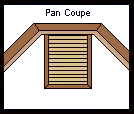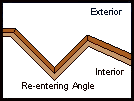
Civil War Field Fortifications
A Glossary of Terms Applied to Civil War Field Fortifications
M - S
Word List
Click on a word to jump to its definition.
 |
Machicoulis were fortified balconies projecting from the upper stories of fortified buildings that allowed the defenders to fire down on attacking enemy troops attempting to assault the lower levels of the buildings. | ||
| Back to Main Word List |
 |
A pan-coupe was a short straight stretch of parapet constructed across the capital of a salient angle. It was intended to allow sufficient space on the parapet at the angle for the construction of an embrasure or to allow barbette mounted cannon to be run closer to the interior slope to fire than would otherwise be possible. The primary effect of a pan-coupe was a reduction in the area of the sector without fire in front of a salient angle. | ||
| Back to Main Word List |
Penetration tables showed how deeply solid shot of various weights might be expected to bury itself in various types of materials used to construct fortifications.This information was used to estimate the thickness required for a parapet, bomb-proof shelter, or magazine to resist the greatest weight of shot that could reasonably be expected to be fired at a field work. In general a parapet had to be from one-third to one-half thicker then the depth of penetration of the weight of shot it was designed to resist to be able to withstand repeated impacts without losing its protective value and allowing shot to penetrate through the parapet to the interior of a work. Rifled artillery delivered both shot and shell of greater weight and at higher velocities than smoothbores and consequently had greater penetrative power. This led to a substantial increase in the thickness of earth works intended to withstand the fire of heavy rifled ordnance. Some of the most massive field works constructed during the Civil War, such as Battery Wagner and Fort Fisher, were designed to resist the destructive effects of heavy rifled naval ordnance.
Mahan's Penetration Table
| Weight of Shot | Penetration into Rammed Earth | |
| Musket Ball | 1 foot, 6 inches | |
| 6-Pounder | 3 1/2 to 4 1/2 feet | |
| 9-Pounder | 6 1/2 to 7 feet | |
| 12-Pounder | 8 1/2 to 10 feet | |
| 18 and 24-Pounders | 11 1/2 to 13 feet |
Mahan's penetration table is from the 1836 edition of his Complete Treatise on Field Fortifications, which was followed in Egbert L. Viele's 1861 work Handbook for Active Service, and was badly out of date by the beginning of the Civil War. It does not account for rifled artillery or small arms and the some cannon referred to were no longer in common use. A later edition of Mahan's work updated the penetration table.
| Nature of Gun. | Penetration. | Thickness of Parapet required. |
| 6-pr. S. B. | 3 1/2 to 4 ft. | 6 to 9ft. |
| 9-pr. S. B. | 6 1/2 to 7 ft. | 9 to 12 ft. |
| 12-pr. S. B. | 8 1/2 to 10 ft. | 12 to 15 ft. |
| 18, 24, and 32-pr. | 12 to 15 ft. | 18 to 25 ft. |
| 68-pr. | 21 to 22 ft. | 25 to 30 ft. |
| 8-in. and 10-in. | 12 to 13 ft. | 15 to 18 ft. |
| 12-pr. B. L. Rifled-gun | 5 ft. | 6 to 9 ft. |
| 20-pr. | 13 to 14 ft. | 15 to 18 ft. |
| 40-pr. | 16 to 17 ft. | 18 to 25 ft. |
| 70-pr. | 17 ft. | 25 to 30 ft. |
| 7-in. | 22 ft. | 25 to 30 ft. |
| Heavy Ordnance | .......... | 30 to 50 ft. |
From Gerald Surman, The Sapper. London, 1877. Provided for comparison with Mahan's table above.
Back to List? Back to Main Word List
Plunging Fire: |
|||
 |
Plunging fire was delivered from considerably higher ground than the target. River batteries were often positioned on high ground to obtain a plunging fire that would strike the vulnerable and unarmored decks of gunboats. | ||
| Back to Main Word List |
 |
A re-entering angle was formed by two faces of a field work joining with their apex projecting toward the interior of the work. Almost all flanks joined faces of field works at re-entering angles. | ||
| Back to Main Word List |
A retrenchment was a parapet or trench constructed in rear of the forward parapet of a field work that defending troops could fall back to when driven from the outer parapet. It was, in effect, a second line of works that could be used to prevent an attacking enemy force from entering the interior of a field work or penetrating through a line of works. When the first Federal mine was exploded under the Third Louisiana Redan at Vicksburg, the Confederates had already constructed a retrenchment or interior parapet fifteen behind the destroyed exterior parapet.
Back to List? Back to Main Word List
 |
Fire that was delivered to strike the rear of a target. | ||
| Back to Main Word List |
 |
Ricochet fire was delivered at a low angle of elevation toward a parapet so that shot would pass over the parapet and bound along the interior side of the parapet. | ||
| Back to Main Word List |
 |
A salient angle was formed by two faces of a field work joining with their apex projecting toward the exterior of the work. | ||
| Back to Main Word List |
Sand-bags were canvas bags measuring about 12 by 30 inches that were filled will loose earth and occasionally covered with tar. They were used to revet slopes and could be substituted for soil to form a parapet and magazine on marshy ground or when speed of construction was a significant necessity.
Back to List? Back to Main Word List
 |
A sector without fire was an angular area extending outward from the capital of a salient angle that could not be reached by direct fire from faces forming the salient. | ||
| Back to Main Word List |
 |
Slant fire was directed at about a 30 degree angle to the the front of a target. It was occasionally considered to be fire at an angle to the rear of a target while oblique fire was fire at an angle toward the front of a target. | ||
| Back to Main Word List |
 |
A structure was said to be splinter proof when it was designed to absorb the impact of shell fragments and spherical case bullets. Splinter proof shelters consisted of heavy post and joist framing covered with plank sheating and two or three feet of rammed earth. Unlike magazines, the side facing away from the direction of enemy fire was left open to allow troops easy access to the shelter. The splinter proof illustrated here is based on the splinter proof at Battery Brown on Morris Island, South Carolina. This construction was reinforced with sandbags and covered over with sand. Splinter proofs were usually sited in rear or to the flanks of heavy siege batteries and were built low enough to gain some protection from the battery's parapet. In batteries, traverses that were not subject to flanking fire were usually only built thick enough to be splinter proof. | ||
| Back to Main Word List |
Contents Home Page Major Works Minor Works Siege Works Permanent Fortifications
Copyright (c)PEMcDuffie 1997, 1998